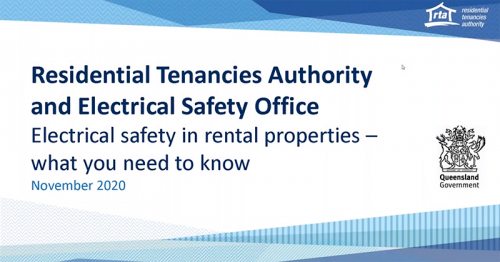Under Queensland laws, both property owners and tenants/residents have responsibilities for electrical safety in a rental property.
Under the Residential Tenancies and Rooming Accommodation Act 2008 (the RTRA Act), property owners must ensure the property is not in breach of any health and safety laws, including the Electrical Safety Act 2002, at the start of the tenancy. Property owners must also maintain the property and any inclusions, as well as undertake any necessary repairs in a timely manner. This is to protect the safety of their tenants and property for the duration of the tenancy. Minimum housing standards also require that fixtures and fittings, including electrical items, are in good repair and won’t cause injury to the tenant.
Tenants/residents have a duty to look out for their own safety and the safety of others by reporting any electrical issues to their property manager/owner in a timely way.
As the property owner’s representatives, property managers are responsible for passing on and actioning repair requests in a timely manner to ensure that electrical safety issues can be addressed.
Whether you are a tenant/resident or a property manager/owner, failure to comply with the Electrical Safety Act 2002 can result in significant fines or even imprisonment for conduct that recklessly exposes someone to a risk of injury or death.
Safety switches
Safety switches protect people from electric shock. They shut off electricity supply when a current leakage is detected. This avoids serious electric shock and possible electric burns by stopping the current flowing through a person. It’s important that the property manager/owner and tenants/residents know where the safety switches are located at the property.
All power point circuits in rental properties must have a safety switch attached. If a safety switch isn’t present, the property owner must ensure an approved safety switch is installed as soon as practical once a proposed tenancy agreement has been sent to the tenant.
Safety switches should be regularly tested by the property manager/owner or the tenant. The responsibility for testing can be discussed at the start of a tenancy agreement. The Electrical Safety Office (ESO) recommends that testing should be done every three months using the test button. If the safety switch does not cut the power to the connected circuit when tested, the tenant should alert the emergency repair contact in their tenancy agreement immediately.
The ESO website includes further information on safety switches and how to test them and safety switch frequently asked questions.
To check or test safety switches, the property manager/owner needs to give tenants appropriate notice and an Entry Notice (Form 9) stating who is entering and when.
Reporting electrical issues and emergency repairs
Under the Residential Tenancies and Rooming Accommodation Act 2008 (the Act), a dangerous electrical fault is classed as an emergency repair. The property manager/owner must provide details of a contact for emergency repairs in the tenancy agreement. The tenancy agreement must also state if the nominated repairer or the property manager/owner should be the first point of contact for emergency repairs.
If a tenant feels an electric shock or tingle from a tap, pipe or other metal fitting, they should:
- Immediately contact their electricity distributor via the relevant number on the ESO website.
- Contact the emergency contact in their tenancy agreement.
The electricity distributor will make the situation safe and investigate the cause. Tenants/residents should stay well clear of the location and warn others. It's important not to touch the meter box, switchboard, appliances or metal fixtures such as taps until the property has been made safe. You can find out more about shocks and tingles on the ESO website.
If the shock or tingle is from a hard-wired fixed appliance such as an air conditioner or oven, tenants should stop using the equipment and notify the emergency contact in their tenancy agreement.
For electrical faults which don’t present a safety hazard, tenants should follow the repairs and maintenance process.
Electrical work must only be performed by a licensed electrical contractor. Tenants and property owners should not attempt to repair electrical issues themselves. Do-it-yourself (DIY) work is dangerous, illegal and will void insurance. You can check if a contractor has a current license using the ESO electrical license search.
More information
Visit the Electrical Safety Office website for more information including guides to download on electrical safety in rental properties for property owners and tenants.
You can also read our article about lithium-ion batteries and electric vehicle chargers in rental properties.
Find out more about your rights and responsibilities for repairs and maintenance in a rental property.


